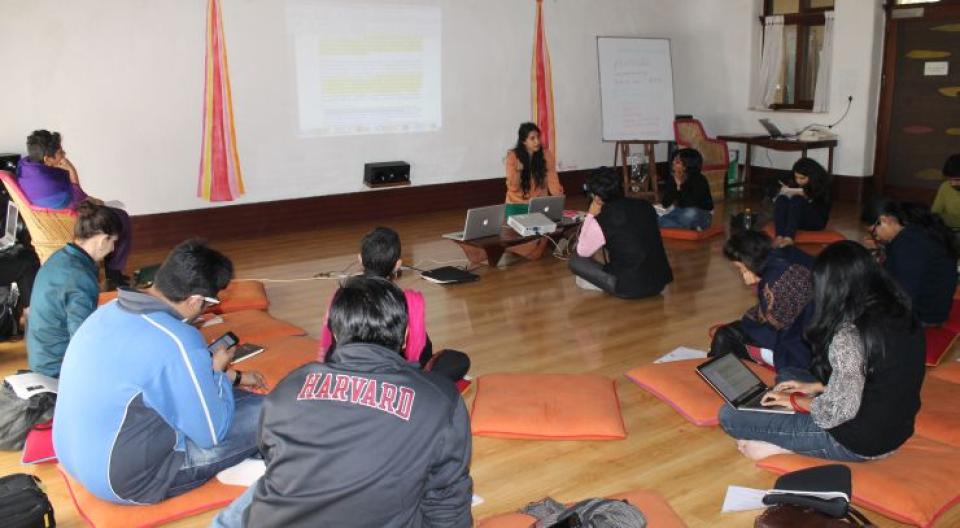
Some were uncomfortable with certain types and scales of violence being represented, such as rape porn or gang-rape porn. Others felt that was just fantasy.
This is the first in a series of posts reporting on the day-long “Tangled, Like Wool” meeting held in New Delhi in January 2014. Through talks, presentations and discussions, the meeting explored the links between pornography, gender, sexuality and the freedom of speech.
Ever since the infamous feminist sex wars of the 1980s, the question of pornography has been an ongoing saga. Anti-sex feminists hold that porn (and other forms of sex work) is necessarily harmful to women, whereas pro-sex feminists believe that sexual freedom is crucial to women’s rights. “Tangled, Like Wool”, a meeting held on 28 January in New Delhi, brought together activists from across the country to discuss and deliberate upon issues pertaining to pornography. All participants at the meeting unanimously opposed the proposed bans on viewing pornography that are currently under consideration in the Supreme Court. However, two important discussions – one led by Bishakha Datta from Point of View and the other by Namita Aavriti from the Alternative Law Forum – focussed on the issue of violence in porn.
Carole Vance, a professor of human sexuality at Columbia University, once asked this question: As a feminist, what makes you uncomfortable about pornography – is it sexual explicitness, sexism or violence?
For participants at the meeting, the sexual explicitness of pornography was never a concern. However, issues around both violence and sexism were raised during the discussions.
The classic feminist line of thinking has always equated pornography with violence, and one continuing concern is that performers involved in porn may experience abuse. Think about when you go to see a ‘regular’ film. Actors and actresses are often shown being beaten up, or even facing sexual violence. But as viewers, we know that it’s not real violence, it’s just acting. When it comes to porn, though, we can never really know whether the violence is an act or whether it’s real. And given that porn is often produced in low-budget, underground or even illegal situations, the rights of actors and actresses aren’t as clearly protected as those who work in mainstream cinema. Consent in porn is complicated, because as viewers, we may never know how much of what we see on screen is consensual and how much is acting.
Another concern is that violence is often shown as pleasurable, and some feminists believe that this glorifies and sanctions violence against women. A 2010 study found that in violent porn, the perpetrators of violent acts are nearly always men, with women as their targets. This means that despite the reality that several people do find consensual violence to be erotic and desirable, there is a gender-inequality when it comes to who is dominating such scenes?
Many anti-porn positions, including the proposed porn ban in India, believe that the representation of violence in pornography leads to violent attitudes and real world violence. For example, a 1989 study found that men who watched more dehumanising forms of pornography supported violent attitudes towards women. (1)
There are, however, many grounds on which such findings can be refuted. Firstly, most studies with similar findings took place in the 80s and early 90s, and it’s unclear whether more recent studies show different attitudes. Furthermore, some studies showing that porn leads to violence may be methodologically flawed. If viewing porn shapes attitudes and behaviour over a long period of time, studies that expose people to porn for a short period of time cannot accurately measure anything. Additionally, porn is not viewed in a vacuum. Many argue that the effects of porn have little to do with the medium itself, and everything to do with the person viewing it. None of the cited studies look at a person’s psyche, socio-economic realities, existing sexual preferences and so on. One study that does consider characteristics of the viewer finds that only those men with a pre-existing hostile masculinity are likely to be influenced by the violence in pornography. A study by the National Online Resource Centre on Violence Against Women (VAWNET) found that “since some men who use pornography don’t rape, and some men who rape don’t use pornography, pornography is neither a necessary nor a sufficient condition for rape”.
There are no conclusive studies that link viewing porn to the perpetration of real world violence. In fact, many people have written about how there is no causal link between viewing any type of media and off screen behaviour. We have a complex relationship with media, and as consumers, we do not simply absorb what we see without filtering it first. Despite this, some participants were uncomfortable with certain types and scales of violence being represented, such as rape porn or gang-rape porn. Others, however, felt that was just fantasy. For example, Jaya Sharma asked, “What is it that we don’t like about violence? It’s important to look at these issues as a continuum. Power pervades all sex. Everyone knows that pain is pleasure and that playing with power is hot… What do we do about darker desires? Maybe porn is a space where you can find your erotic satisfaction”.
When we think about the effects of violence in pornography, we assume that the only viewers of porn are men. But an EroTICs study found that 60 percent of surveyed women had used the internet to access sexual content. Presumably, at least some of this content was porn. Studies across the world demonstrate that women consume, watch and enjoy pornography. Linking porn to violence removes women viewers from the conversation.
From a woman viewer’s perspective, the sexism perpetuated by pornography may be problematic. Porn places a strong emphasis on the female body, and often perpetuates stereotypes of what “beautiful” or “regular” body types are. Women who watch porn, and in particular young women, may be adversely influenced by these unrealistic representations of female bodies. But an important point to consider is that a lot of media does the same thing: the ads we see or the films we watch are filled with manipulated and airbrushed graphics of impossibly thin women. While porn does contribute to these sexist representations, it certainly isn’t the only culprit.
The relationship between violence and porn can perhaps be compared to the role of alcohol in domestic violence. Many people used to once believe that domestic violence was caused by alcohol. In reality, and as we now know, alcohol can at best be seen as a contributor to domestic violence, but certainly not as its cause. In the same way, there is no evidence to suggest that porn causes violence against women, though in some cases, it may possibly contribute to it. The defining condition for domestic violence, sexism in media, and pornography, is patriarchy, and to attack the medium or expression does not target the cause.
Footnotes
(1) Check, J. V. P., & Guloien, T. H. (1989). The effects of repeated exposure to sexually violent pornography, nonviolent dehumanizing pornography, and erotica. In D. Zillmann & J. Bryant (Eds.), Pornography:Research Advances and Policy Considerations (pp. 159-184). Hillsdale, NJ: Erlbaum.
- 7658 views






Add new comment